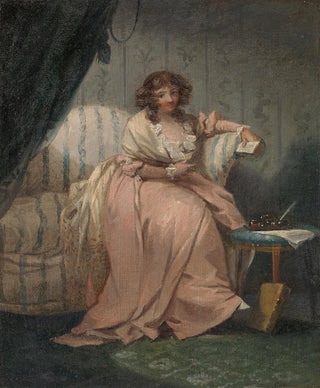Art print | A woman named Anne, the artist's wife - George Morland


View from behind

Frame (optional)
In the fascinating world of 18th-century British art, the artwork "A woman named Anne, the artist's wife - George Morland" stands out for its emotional depth and palpable intimacy. This delicate depiction of Anne, Morland's wife, is not merely a portrait; it is an open window into the artist's life and the era in which he lived. Through this piece, viewers are invited to discover a personal story, a connection between the artist and his model that transcends a simple representation. The image of Anne, imbued with tenderness and melancholy, evokes an atmosphere of introspection and affection, captivating the eye and mind of those who linger on it.
Style and uniqueness of the work
George Morland's style is characterized by a realistic and sensitive approach, blending elements of everyday life with refined aesthetics. In "A woman named Anne, the artist's wife," Morland manages to capture not only the physical features of his wife but also an emotional essence that resonates with anyone who observes it. The nuances of color, the soft light caressing Anne's face, and the carefully orchestrated composition create an intimate atmosphere. The artist skillfully uses play of shadow and light to emphasize the subtle expressions of his model, making the work lively and vibrant. This portrait, far from being a simple representation, becomes an exploration of human relationships, a testament to the love and complicity that unite Morland and his wife.
The artist and his influence
George Morland, born in 1763, is often regarded as one of the most influential painters of his time, notably for his ability to capture rural life and genre scenes. His artwork "A woman named Anne, the artist's wife" fits into a period when art began to move away from academic conventions to embrace more personal and introspective themes. Morland, with his unique style and sensitivity, paved the way for a new way of conceiving the portrait, where the individuality of the subject takes precedence.

Matte finish

View from behind

Frame (optional)
In the fascinating world of 18th-century British art, the artwork "A woman named Anne, the artist's wife - George Morland" stands out for its emotional depth and palpable intimacy. This delicate depiction of Anne, Morland's wife, is not merely a portrait; it is an open window into the artist's life and the era in which he lived. Through this piece, viewers are invited to discover a personal story, a connection between the artist and his model that transcends a simple representation. The image of Anne, imbued with tenderness and melancholy, evokes an atmosphere of introspection and affection, captivating the eye and mind of those who linger on it.
Style and uniqueness of the work
George Morland's style is characterized by a realistic and sensitive approach, blending elements of everyday life with refined aesthetics. In "A woman named Anne, the artist's wife," Morland manages to capture not only the physical features of his wife but also an emotional essence that resonates with anyone who observes it. The nuances of color, the soft light caressing Anne's face, and the carefully orchestrated composition create an intimate atmosphere. The artist skillfully uses play of shadow and light to emphasize the subtle expressions of his model, making the work lively and vibrant. This portrait, far from being a simple representation, becomes an exploration of human relationships, a testament to the love and complicity that unite Morland and his wife.
The artist and his influence
George Morland, born in 1763, is often regarded as one of the most influential painters of his time, notably for his ability to capture rural life and genre scenes. His artwork "A woman named Anne, the artist's wife" fits into a period when art began to move away from academic conventions to embrace more personal and introspective themes. Morland, with his unique style and sensitivity, paved the way for a new way of conceiving the portrait, where the individuality of the subject takes precedence.






